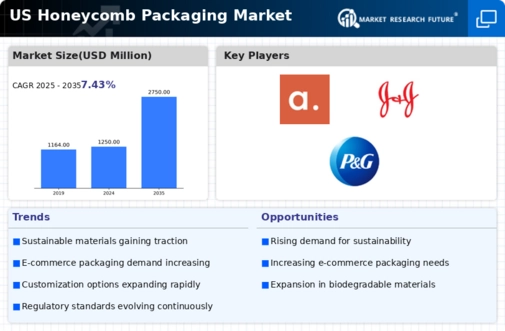Increased E-commerce Activities
The honeycomb packaging market is experiencing a boost due to the rapid growth of e-commerce activities in the US. As online shopping continues to gain popularity, the demand for packaging that can withstand the rigors of shipping and handling is paramount. Honeycomb packaging, with its lightweight and durable characteristics, is particularly suited for protecting products during transit. The e-commerce sector is projected to reach $1 trillion in sales by 2025, creating a substantial opportunity for the honeycomb packaging market. Companies are increasingly recognizing the importance of reliable packaging solutions that not only protect goods but also enhance the unboxing experience for consumers. This trend is likely to drive further innovation and investment in honeycomb packaging solutions.
Growth in the Food and Beverage Sector
The honeycomb packaging market is significantly influenced by the expansion of the food and beverage sector, which increasingly requires efficient and protective packaging solutions. With the US food and beverage industry projected to reach $1.5 trillion by 2026, the demand for packaging that ensures product safety and freshness is paramount. Honeycomb packaging, known for its lightweight yet sturdy structure, offers excellent protection against damage during transportation and storage. This characteristic is particularly appealing to food manufacturers who prioritize quality and safety. As the honeycomb packaging market continues to evolve, it is likely to see increased adoption within this sector, driven by the need for innovative packaging solutions that meet both consumer expectations and regulatory standards.
Technological Innovations in Packaging
Technological advancements are reshaping the honeycomb packaging market, introducing new materials and manufacturing processes that enhance product performance. Innovations such as automated production lines and advanced design software enable manufacturers to create customized packaging solutions that cater to specific industry needs. The integration of smart packaging technologies, which can provide real-time data on product conditions, is also gaining traction. This evolution in the honeycomb packaging market not only improves efficiency but also reduces costs associated with production and waste. As companies invest in these technologies, the market is expected to witness a compound annual growth rate (CAGR) of around 5% over the next five years, indicating a robust growth trajectory fueled by innovation.
Rising Demand for Eco-Friendly Packaging
The honeycomb packaging market experiences a notable surge in demand driven by the increasing consumer preference for eco-friendly packaging solutions. As environmental awareness grows, businesses are compelled to adopt sustainable practices, leading to a shift towards materials that minimize ecological impact. In the US, the market for sustainable packaging is projected to reach approximately $400 billion by 2027, with honeycomb packaging playing a pivotal role due to its recyclable and biodegradable properties. This trend not only aligns with consumer values but also enhances brand loyalty, as companies that prioritize sustainability often enjoy a competitive edge. The honeycomb packaging market is thus positioned to benefit from this rising demand, as more manufacturers seek to innovate and provide environmentally responsible packaging options.
Regulatory Support for Sustainable Practices
The honeycomb packaging market benefits from increasing regulatory support aimed at promoting sustainable practices within the packaging industry. Various state and federal initiatives encourage the use of environmentally friendly materials, which aligns with the characteristics of honeycomb packaging. Regulations that limit single-use plastics and promote recycling initiatives are likely to create a favorable environment for the honeycomb packaging market. As companies strive to comply with these regulations, the demand for sustainable packaging solutions is expected to rise. This regulatory landscape not only fosters innovation but also encourages collaboration among manufacturers, leading to the development of new products that meet both consumer and regulatory expectations.














Leave a Comment